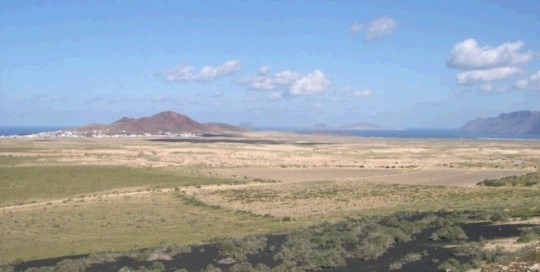These are the oldest in the Canary Islands as they were exploited in the 16th Century. They are on a flat surface at the bottom of the Famara cliff, separated from the island of La Graciosa by the river "El Río". The plain it is on, consists of detrital materials that resulted from the erosion [...]
LZ05 Peñas de Tao
carlosdpp2021-03-09T13:45:17+00:00The best example in Lanzarote of the presence of numerous erratic blocks, reaching more than 30 m in height. The erratic blocks are described as large rock fragments transported by the lava. In this case, the large blocks come from the partial destruction of one of the flanks of the volcanic building of Volcán de [...]
LZ06 Tubo volcánico de La Corona- Atlántida
carlosdpp2021-03-09T13:44:24+00:00It formed after the eruption of Volcán de La Corona around 25 ka BP. It is more than 7.6 km long. It consists of a complex of halls and galleries superimposed with domes of up to 20x20 m and small interior lagoons. On the surface, the tube stands out because of a linked succession of [...]
LZ07 Valles colgados de Famara
carlosdpp2021-03-09T13:41:49+00:00It includes some complex valleys when it comes to their evolution and morphology, and lacks heads and mouths. The are headless valleys that appear to be hanging at the top as a consequence of the formation of the cliff of Famara. But, in addition, in the middle stretches, the location of the recent lava flows [...]
LZ08 Valle de Temisa
carlosdpp2021-03-09T13:39:44+00:00It corresponds to a broad basin with a soft longitudinal bed and a broad transversal profile typical of “U” valleys. The origin of these types of morphologies is related to the alternating damp and semi-arid stages that favour fitting at the bottom of the ravine and the setback of the hillsides, respectively. These are valleys [...]
LZ09 El Jable
carlosdpp2021-03-09T13:37:16+00:00A wind sand corridor of active organic wind sand that runs through the island north to south, from Caleta de Famara to Playa Honda-Arrecife. From the sedimentary sequence of the Jable we gather the alternating climate, from arid thumbed during the Quarterly and the end of the Pliocene. On the coast, there are marine deposits [...]
LZ10 El Cuchillo-Mosta-Montaña Cavera
carlosdpp2021-03-09T13:35:10+00:00This is the area with the highest concentration of surtseyan cones in all the Canary Islands. The three volcanic buildings that make up the geosite are aligned according to a NE-SW eruptive fissure. In these volcanic buildings, we can clearly follow the complete transition from the initial stages of the hydromagmatic building, with interaction of [...]
LZ11 La Santa
carlosdpp2021-03-09T13:31:41+00:00La Santa is a geosite formed by coastal marine deposits (sandstone and carbonated gravel, grindstone type) containing abundant fossils such as corals of a specific species, the Siderastraea radians, corresponding to the last interglacial (Eemiense). This is the most northern location in the Atlantic where this species of coral can be found, marking the most [...]
LZ12 Las Laderas
carlosdpp2021-03-09T13:30:42+00:00Paleo-cliff corresponding to the topographic end of Risco de Famara. It is totally disconnected from the current coastline. At its base, it has developed two well-differentiated generations of detrital fans evolving towards glacis on the distal area. In this distal area, the glacis deposits intertwine with wind Jable sand deposits. There are numerous outcrops where [...]
LZ13 Barranco de Tenegüime
carlosdpp2021-03-09T13:29:36+00:00This is a clear example of a valley with a transversal “V” profile. A straight ravine where the erosion of the water has excavated the complete sequence of the materials that form the Famara Massif, draining towards its eastern slope / watershed. The ravine seems to be fitted on a NW-SE fault plain, a factor [...]










